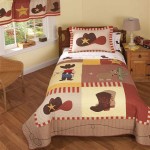When Do Babies Have Bedding?
Welcoming a new baby into the world is a joyous occasion, and preparing their nursery is an exciting task. One important consideration is when to introduce bedding into your baby's crib. Understanding the right time and factors to consider will help ensure a safe and comfortable sleeping environment for your little one.
Newborn Sleep Patterns
During the first few months, newborns spend most of their time sleeping. They typically sleep for short periods, waking frequently to feed and be changed. This means they don't need much bedding in their crib. In fact, the American Academy of Pediatrics (AAP) recommends that babies sleep on a firm sleep surface with a fitted sheet only, without any blankets, pillows, or stuffed animals. This helps reduce the risk of Sudden Infant Death Syndrome (SIDS) and other sleep-related deaths.
Transition to Bedding
As your baby grows and develops, their sleep patterns will gradually change. They'll start sleeping for longer periods and may begin to roll over. At this point, you can consider introducing bedding to their crib. However, it's important to wait until your baby is at least 12 months old to minimize the risk of SIDS.
Choosing the Right Bedding
When selecting bedding for your baby, there are a few important things to keep in mind:
- Fitted Sheet: Choose a fitted sheet that fits snugly on your baby's crib mattress to prevent bunching or gaps.
- Blankets: Choose lightweight, breathable blankets that can be easily kicked off if your baby gets too warm. Avoid heavy quilts or comforters, as these can pose a SIDS risk.
- Pillows: Pillows are not recommended for babies under 2 years old, as they can increase the risk of SIDS and other sleep-related deaths.
- Stuffed Animals: Keep stuffed animals and other soft toys out of the crib during sleep time to minimize the risk of suffocation.
Maintaining a Safe Sleep Environment
In addition to choosing the right bedding, it's important to maintain a safe sleep environment for your baby:
- Sleep Position: Always place your baby on their back to sleep, as side or stomach sleeping increases the risk of SIDS.
- Room Temperature: Keep the room temperature between 68°F and 72°F (20°C to 22°C) to prevent overheating.
- Avoid Smoking: Avoid smoking in the house or near your baby, as secondhand smoke increases the risk of SIDS.
By following these guidelines, you can ensure a safe and comfortable sleeping environment for your baby, promoting sound sleep and healthy development.

When Is It Safe For My Baby To Sleep With A Blanket

When Can Your Baby Sleep With A Blanket At Night

When Can Babies Use Blankets Pillows

Nih Alerts Caregivers To Increase In Sids Risk During Cold Weather National Institutes Of Health

When Can Babies Sleep With Blankets Babycenter

How To Keep Your Baby Warm At Night And Why S Hands Feel Cold Babycenter

Safe Sleep For Infants Marin Health And Human Services

Newborn Bassinet Safety Tips

7 Vital Sleep Rules To Help Keep Your Baby Safe Madeformums

When Is It Safe For My Baby To Sleep With A Blanket








